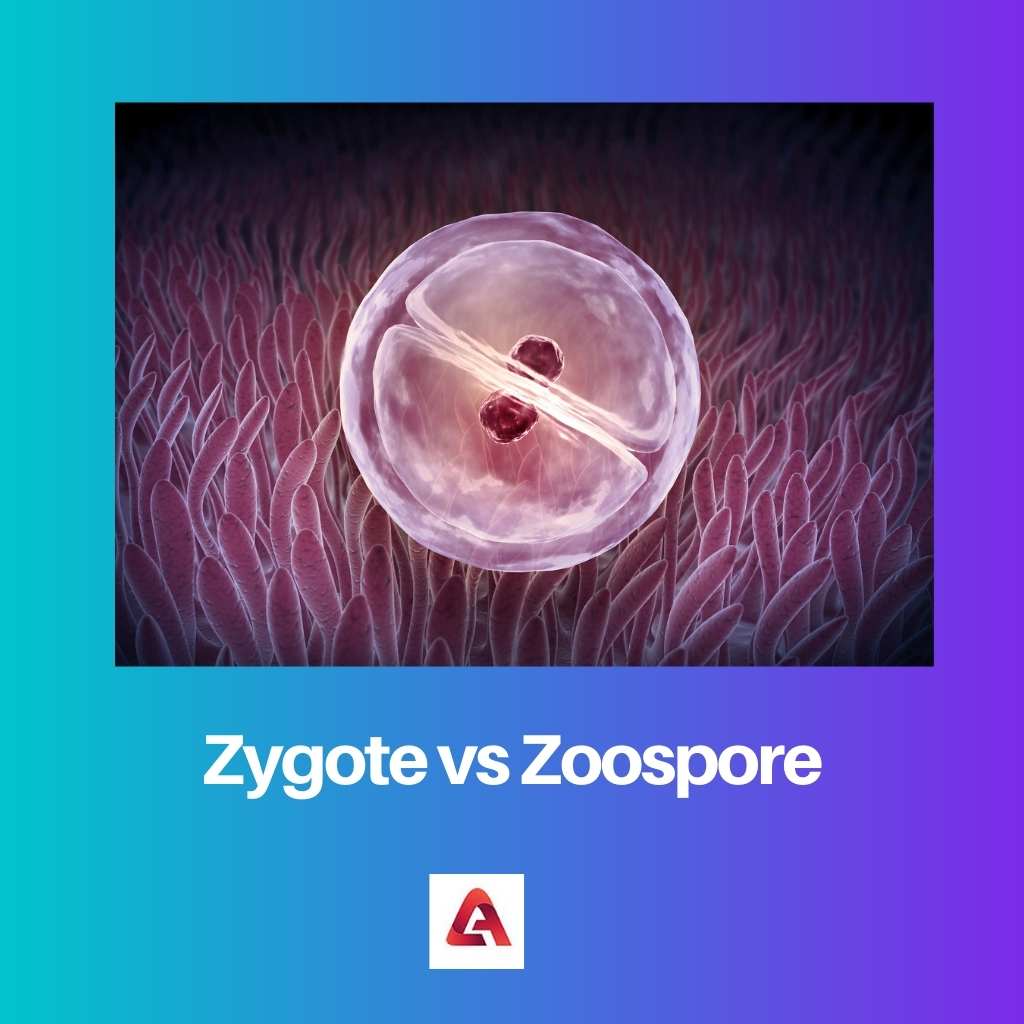Reproduction is categorized as sexual and asexual modes. In the asexual mode of reproduction, the resultant is a zoospore whereas, in the sexual mode of reproduction, the resultant is a zygote.
Both the forms produce new offspring similar to parents in many aspects.
Key Takeaways
- A zygote is a fertilized egg cell formed by the fusion of sperm and egg, while a zoospore is an asexual, motile spore produced by some algae, fungi, and protozoa.
- Zygotes are the starting point for multicellular organism development, while zoospores facilitate asexual reproduction and dispersal in their respective organisms.
- Zygotes develop through cell division and differentiation, while zoospores germinate into new individuals upon finding a suitable environment for growth.
Zygote vs Zoospore
Zoospores are produced during asexual reproduction in some types of fungi, algae, and protozoa. Zygotes are larger, contain more genetic material than zoospores, and can create new organisms. Zoospores are used for dispersal and can form new individuals through germination.

A zygote is the most common term mainly used during the sexual mode of reproduction. The formation of the zygote is mainly carried out in higher and well-developed categories of organisms such as plants and humans.
The progeny resemble their parent with the basic similarities while maintaining their different identity.
Zoospore is one of the most common spores used for reproduction. Zoospores are more commonly found in low-developed species of fungi and bryophytes.
Also, the zoospores contain flagella which are the main mode of transportation from one parent to other. Moreover, zoospores need a medium for this transportation, as water is used as the medium.
Comparison Table
| Parameters of Comparison | Zygote | Zoospore |
|---|---|---|
| Definition | A zygote is formed by the fusion of male and female gamete. | A zoospore is a type of flagellated spore. |
| Mobility | A zygote is a non-motile eukaryotic cell. | A zoospore is a motile eukaryotic cell. |
| Presence of Flagella | In a zygote, no Flagella is found. | In a zoospore, Flagella is found and their number varies from species to species. |
| Formation type | A zygote is formed only through the sexual mode of fertilization | A zoospore is formed through the asexual mode of reproduction. |
| Occurrence | The occurrence of the zygote is found in humans and plants. | Zoospore commonly occurs in some protests, bacteria, and fungi. |
What is Zygote?
A eukaryotic cell so formed by the fusion of male and female gamete is technically known as a zygote. The zygote contains all the genetic data that is needed for the development of an organism.
The zygote contains the DNA content from both the gametes. The zygote eventually leads to the formation of blastomeres.
According to multicellular organisms, the earliest stage of development is the zygote. In multicellular organisms such as angiosperm and humans, when the female gamete egg is fertilized by the male gamete a sperm.
This type of fertilization is termed sexual reproduction. In asexual reproduction, the zygote reproduces by asexual mode and hence forms clones as offspring.
In the late 19th century, Richard Hertwig and Oscar, German Zoologists made the pioneer discoveries in the development of the animal zygote. In human reproduction, the male and female gametes are haploid in terms of DNA content.
The term haploid means to have only a single set of chromosomes. While talking about fertilization in humans, a zygote is formed when a sperm, the male gamete, and secondary oocyte, the female gamete meet to form a zygote.
A zygote is diploid and contains double sets of chromosomes. This zygote finally divides to form an embryo and this embryo further implants in the uterus of a female.

What is Zoospore?
An asexual spore formed mainly containing a flagellum or group of flagella. Zoospore is categorized as a motile spore due to the presence of flagella.
These spores are mainly formed outside the female and male bodies. So this zoospore needs to reach the female body for nutrition and nourishment.
The only means to reach the destination is through water and hence known as swarm spores. The zoospore flagella are further categorized into two classes based on the number of the flagellum.
The tinsel type contains several flagella and is called the decorative one whereas the single flagellum is called whiplash.
In the tinsel arrangement, one main flagellum contains perpendicular flagella known as mastigoneme arranged all over the main axis.
These mastigonemes allow the zoospore to sense with a larger surface area and works as a paddle while surfing on the surface of the water.
While looking at whiplash flagella, only a single flagellum is present and is used as a propeller while freely swimming in the water.
However, both types of flagella can occur in the zoospore. According to this condition, there are four main categories of different locations of flagella.
Organisms belonging to Chytridiomycota possess posterior whiplash flagella as a characteristic feature.
In some species of Myxomycota and Plasmodiophoromycota, there are two flagella in a single zoospore. These two flagella are of unequal lengths.
Also, some species of Hyphochytriomycetes, zoospores contain single anterior flagella which are of tinsel type.

Main Differences Between Zygote and Zoospore
- The zygote is mostly found in higher species such as humans, plants, and some species of fungi whereas zoospore is found low developed species of fungi and Bryophyta.
- The offspring formed by the zygote share similarities with their parents whereas the offspring formed by zoospores are purely identical and referred to as clones.
- The zygote, after formation, is implanted in the female body whereas the zoospore struggles to attach with a female parent.
- The zygote is formed inside the female body whereas the zoospore is formed outside the female body.
- The zygote does not need a medium to reach the female body whereas the zoospore needs a medium to travel to the female parent.
- https://www.science.org/doi/abs/10.1126/science.266.5185.605
- https://academic.oup.com/humrep/article-abstract/15/12/2591/2915856
- https://www.sciencedirect.com/science/article/pii/S1749461307000073
- https://www.tandfonline.com/doi/abs/10.1080/08927010009386297
